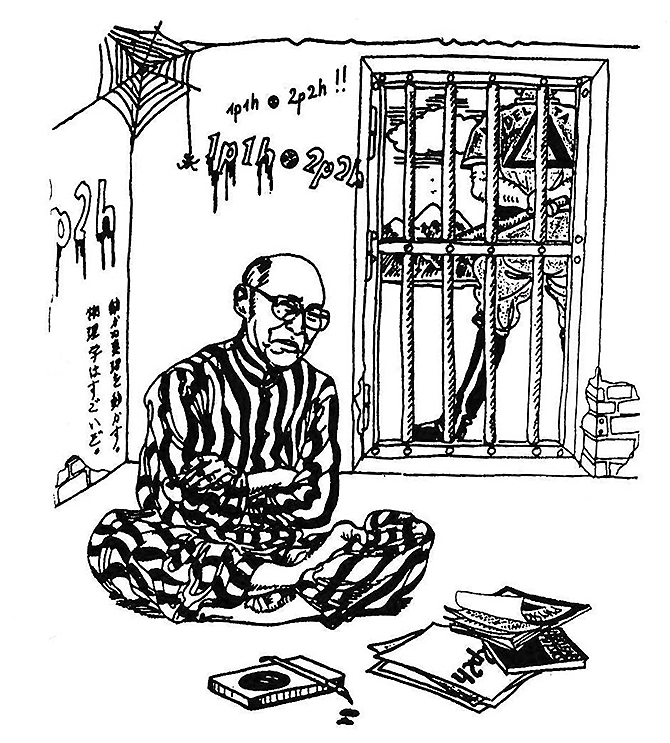Disclaimer: machine translated by DeepL which may contain errors.
Dr. Akito Arima, the "Imprisoned" Professor
|
Dr. Akito Arima was imprisoned at the "International Conference on Nuclear Spin Excitation" held in Colorado, USA in 1982. At the summary of the conference, Dr. E. Vogt, Director of TRIUMF Institute in Canada, projected a portrait of Dr. Arima on the screen and humorously showed a stack of iron bars saying, "The interpretation that Dr. Arima insists is outdated and it is time to accept the modern interpretation based on quarks. The figure on the right is a later reproduction of this scene.

In the 1970s, the spin giant resonance state of nuclei was discovered. The problem was that the magnitude of the resonance state (sum of transition intensities) was experimentally observed to be only about half of the value predicted by quantum theory. Since the transition strength does not disappear in the quantum theory, the missing transition strength problem became a major puzzle. To explain this, A. Bohr (Aage Niels Bohr) and B. Mottelson (Ben Roy Mottelson) proposed a theory that this missing problem could be solved by considering even the spin excited states of nucleons themselves, called delta particles, which reflect the quark structure of nucleons. The long-awaited quark effect. Many nuclear scientists agreed with this interpretation of the long-awaited quark effect. The international conference was held under these circumstances. Dr. Arima took the podium on the first day of the conference and argued, differently from Bohr et al., that a detailed analysis of the magnetic moment shell model showed that quarks were involved in at most 10% of the transitions, and that most of the transition intensities should be distributed at higher excitation energies than the resonance state. As a result, Dr. Arima was under siege by the tremendous criticism from the audience. This excited atmosphere was expressed in Mr. Focht's summary and illustrated in the figure on the right. Even after this, Dr. Arima continued to struggle on his own and to assert his theory all over the world.
 Figure: Illustration reproduced later by Nguyen Ding Dang (upper right) and the scene of his release (above) newly drawn at the request of Professor Glasshauser.
Figure: Illustration reproduced later by Nguyen Ding Dang (upper right) and the scene of his release (above) newly drawn at the request of Professor Glasshauser.(Nguyen Ding Dang, International Symposium on Spin Giant Resonance, Tokyo, 1997)
In the 1990s, the Sakai group at the University of Tokyo constructed a fast neutron experimental facility at the Research Center for Nuclear Physics (RCNP), Osaka University, and obtained high-quality data over a wide excitation region, including spin giant resonance states. From detailed data analysis, they found that about 40% of the transition intensities (90% in total) are widely dispersed in the region above the excitation energy of the spin giant resonance. This finding solved the "transition strength deficit problem" and proved that Dr. Arima's claim was correct. In 1997, the "International Symposium on Spin Giant Resonance" was held at the University of Tokyo. In the summary of the symposium, Professor C. Glashausser of Rutgers University congratulated Dr. Arima by showing an illustration of his release from prison (see below).
Even though he became busy with other things besides his research, Dr. Arima always continued his research even as he grew older. Although his research field differed from theory to experiment, I learned a lot from his attitude as a researcher. The busy but fulfilling days spent preparing for the international conference mentioned above are one of my unforgettable memories and treasures of Dr. Arima. I sincerely pray for the repose of Dr. Akito Arima's soul.
Published in Faculty of Science News March 2021


